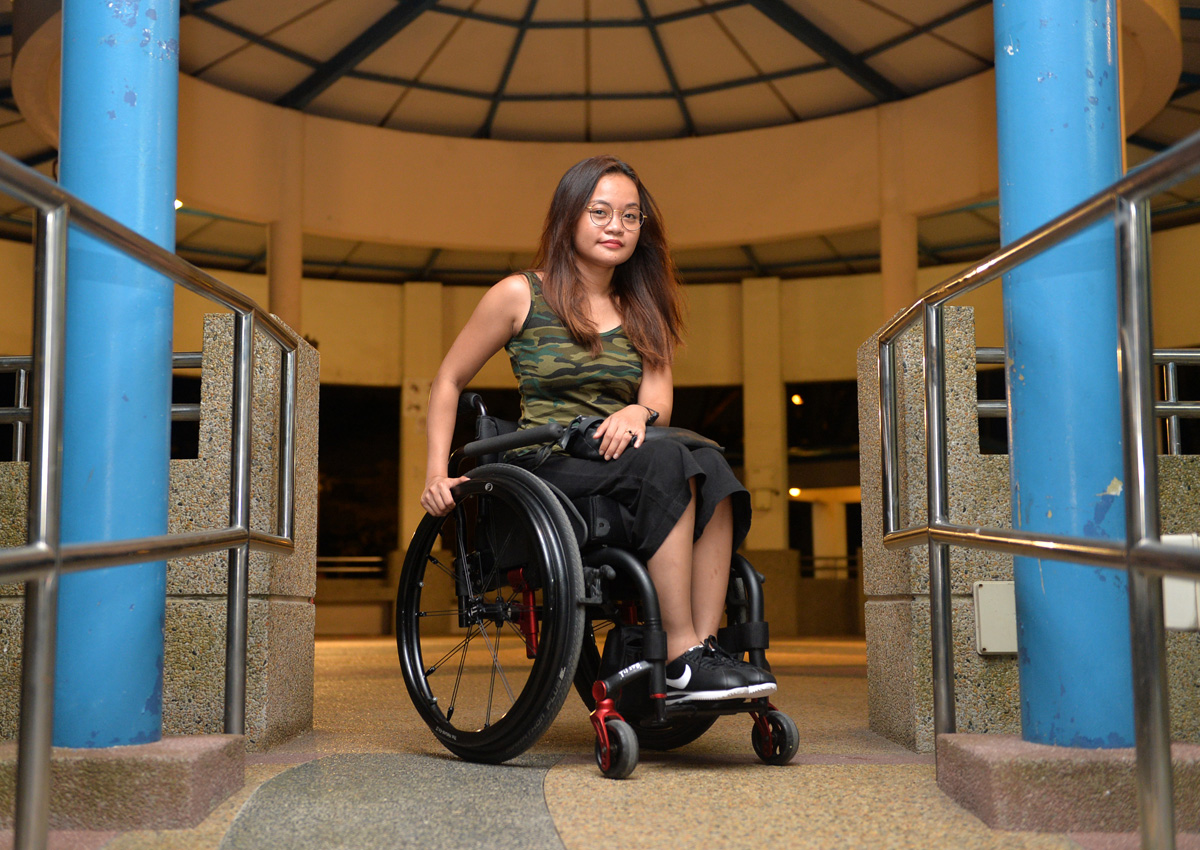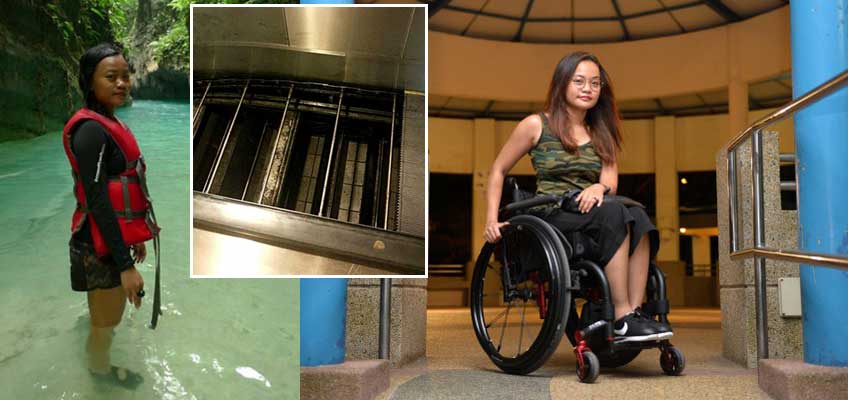One moment, she was on an escalator, rushing to meet friends at Paya Lebar.
The next, she had fallen into a gap on the third step of a descending escalator undergoing maintenance at Tanah Merah MRT station and was unable to move or breathe.
“One of my lungs was punctured and my face was torn open,” employment support specialist Azlin Amran, 31, told The New Paper on Monday, describing the incident that changed her life on Jan 28, 2013.
“I was bleeding badly and I thought, ‘This is it. I’m going to die.'”
She shouted for help – or thought she was – for over 30 minutes. Fortunately, a passer-by heard her soft cries and called the Singapore Civil Defence Force (SCDF).
“I had lost a lot of blood by then and to keep me conscious, the officers kept talking to me, asking me questions,” said Ms Azlin, adding that she could not remember the contents of the conversation itself.
In a previous report, SCDF said its officers arrived to find Ms Azlin conscious and in a sitting position, stuck inside an escalator maintenance pit hole that was waist-deep and located at the upper portion of the escalator.
The rescuers had to first prise open the escalator steps next to her to create more space to effectively set up their rescue equipment.
They used a hydraulic cutter to cut away two beams within the escalator pit hole, located near Ms Azlin’s leg and back.
Paramedics also went into the escalator pit hole to give her oxygen and they managed her spine by using a cervical collar to support her neck and head.
The rescue operation took about 25 minutes.
“I continued to tell them that I could not breathe when they loaded me into the ambulance and also at the A&E (Accident and Emergency Department),” said Ms Azlin.
She lost consciousness after she gave her mother’s contact details to a doctor at the hospital.
Ms Azlin learnt about her condition from a WhatsApp group chat.
The fall had fractured her pelvis and severed the nerves in her spinal cord.
“When I came to after the operation, I was in the ICU (intensive care unit) and I could not feel my legs,” she said.
“Everyone around me was trying to give me hope that I would walk again – until I got my phone back and caught up with what was being discussed in a WhatsApp group I shared with my friends.”
PARAPLEGIC
Her friends were upset about her being left a paraplegic after the mishap.
“They meant well and were talking about miracles and hopes. They forgot I was able to access the conversation,” said Ms Azlin.
“That was when reality hit. I spent every day in the ward crying.
“The painful part was not the accident but realising that I had lost my independence.”
She added that she was more sad than angry, but the stubborn streak in her spurred her on.
“The physical pain was nothing compared to the mental, emotional and spiritual pain,” she said.
“I refused to let them defeat me, so I worked at regaining my independence.
“I wasn’t going to bank my hopes on walking again.
“Nerves do not regenerate, so that avenue was out, but I wanted my independence back. I wanted to return to work.”
Ms Azlin was then working as an administrative and operations executive.
She worked hard at physiotherapy and started getting observant about her surroundings.
“For one, I have to get over my fear of escalators and taking the train,” said Ms Azlin.
“The first time after the accident, when I saw an escalator track, I thought I was going to faint. I forced myself to get over the fear.
“Also, I realised the gaps between the platform and the train were huge, and without proper training on the wheelchair, I wouldn’t be able to travel alone.”
Today, Ms Azlin leaves for work at 6.45am, wheeling herself to the MRT station, and returning home at 6.45pm on her own.
Her mother, Madam Azizah Mohd Lajis, 55, still worries for her.
Ms Azlin said: “I know she still gets a bit teary, but I cannot let that stop me from regaining my independence.”
The once sporty woman who would go trekking overseas or play badminton with friends now has to “redefine what is adventure for me”.
“I used to love swimming in the sea, feeling the waves beat against my legs as I stood in it,” said Ms Azlin, holding back her tears.
“Now I can’t even wheel myself on the sand to dip my toes in the waters.
“Going on an adventure now is getting myself to the park where I can enjoy the natural surroundings or sitting by the sea and watching the waves lap against the sand.”
But her condition has not stopped her from travelling.
“My last solo trip before the accident was to trek in Nepal. That was when there was a strike in the country,” she said.
“Last year, I went on a campervan trip in New Zealand with my mother, my cousin and a friend. It was my first trip after the accident. It was different, but it was exhilarating.”
BABY STEPS
Ms Azlin is back to playing badminton and was competent enough to be sent to Taiwan by the Singapore Disability Sports Council for training.
“I don’t want to let my predicament get me down,” she said.
“I work hard to regain my independence and not let my own powers to be taken away from me. There is satisfaction in knowing that despite being in a wheelchair, I can still work, travel and play sports.”
“It’s all about taking baby steps, improvising and living.”
Out of court settlement
Following the incident on Jan 28, 2013, Ms Azlin Amran sued SMRT for negligence and sought about $3 million in damages.
SMRT settled the lawsuit last week for a final payout of an amount that neither party would disclose.
Medical reports were tendered in court to support Ms Azlin’s claims and attest to the seriousness of her condition.
Through lawyer Nadia Moynihan, Ms Azlin alleged that SMRT had failed in its duty of care and sought special and general damages to pay for her medical treatment, caregivers and loss of earnings.
In its defence, SMRT contested the claims, arguing that Ms Azlin had caused or contributed to her injuries by failing to keep a proper lookout, among other things.
A High Court case management conference was held before Assistant Registrar Janice Wong and the case had been amicably settled out of court.
In March, SMRT was fined $120,000 after pleading guilty to one charge under the Workplace Safety and Health Act.

This article was first published on May 11, 2016.
Get The New Paper for more stories.
















